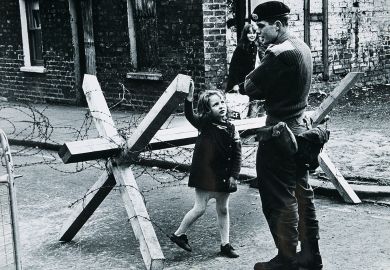The Great Exhibition held in London in 1851 was housed in a temporary prefabricated building of iron, wood and glass. Visitors to the exhibition would have found that the stock of the capital's permanent buildings for culture and administration was then limited to the recently rebuilt National Gallery, a single enfilade of rooms accommodated behind William Wilkins's inadequate facade to Trafalgar Square, and the British Museum, rather more substantially and satisfactorily housed in Bloomsbury. Parliament sat in its recently rebuilt palace, and part of the administration of Britain was carried out in Somerset House, the only purpose-built office building which the state had been able to commission. The rest was conducted in and around Whitehall in ad hoc collections of houses, occasionally united by knocking holes through the party walls, and hopelessly inefficient, ill lit and insanitary, and mostly leased or rented. The business of the War Office, for example, was conducted from 11 scattered offices.
The cost of these arrangements had begun to disturb the Treasury. Commissioning new civil government buildings sanctioned by Parliament was the responsibility of the Office of Works. With parliamentary records, correspondence and a profusion of illustrations and plans, Michael Port's history minutely describes the activities of this department in two periods, from 1851 to 1873, and from 1873 to 1915.
While by mid-century the location of the British Museum was well-established, its constituents were the result of a series of accidents and included antiquities, natural history specimens and books and prints. All these collections were growing so fast that, for example, large sculptures of Assyrian winged horses arriving from Nimrud had to be left unpacked in the shelter of Smirke's colonnade. The animal and vegetable specimens were eventually housed in the new Natural History Museum in South Kensington completed only in 1886. The National Gallery had an even more colourful history. Wilkins's building was despised, there was no room for expansion to the north, half of it was occupied by the Royal Academy, and attempts to get Members of Parliament to vote money for its expansion or removal to a new building on another site were met by eerily familiar questions as to whether it was proper for the state to support or sponsor the display of paintings, especially foreign ones.
The accommodation of the Foreign Office was felt to be inadequate, lacking in dignity, and looking increasingly poor compared with developments elsewhere in Europe, particularly in Paris. A competition for a block plan for new offices for the Foreign and new India Office on the site south of the Horse Guards and between Green Park and Whitehall was held in 1856-57. Using drawings and records Port is able to describe the confusion which resulted from the poor drafting of the competition's rules, and the fact that the state did not own all the land for which proposals were being invited. He shows George Gilbert Scott to have been a particularly sharp operator in abandoning his Gothic scheme, which had won third prize, for Palmerston's preferred Italian. Scott's appeal to the "Englishness" of Gothic, used later by G. E. Street in defending his Royal Courts of Justice, was met by Palmerston's comment: "The real aboriginal architecture of this country was mud huts and wicker wigwams."
The story of the commissioning of the last great Gothic building, the Royal Courts of Justice, finished in 1882, is similarly told in vivid detail: the competition, the changes of site from Carey Street to the Embankment and back again, the instructions of the Treasury to remove features which it thought expensive and gratuitous, the constant sniping by leaders in The Times at poor Street's planning and particularly at his design for the elevation to the Strand are all illustrated in plans and competition drawings.
In spite of the difficulties of Parliament in commissioning and providing funds for new government buildings, in the 65 years between the Great Exhibition and the outbreak of the first world war London had been equipped with many of the buildings required by a modern European state. The explicit celebration of empire was characteristically left to the public subscriptions which provided Aston Webb with the opportunity to design the Queen Victoria Memorial at one end of the Mall, and the Admiralty Arch at the other.
Port's authoritative and beautifully written study provides a remarkably detailed account of this extraordinary period, and forces a reassessment of Sir John Summerson's dismissal of much of Victorian building. The illustrations, especially the photographs of the interiors of buildings not usually accessible to the public, are particularly valuable, and the many plans illustrate how complex are the processes which finally bring about an important building or street.
London was founded on trade and manufacturing industry and its functions as a centre for the court and government have been coincidental decorations. Its industry withering, and its trade now largely in the volatile domain of money, and without a representative body to propose another strategy, London seems blessed or doomed to rely on international tourism. Roy Porter's London: A Social History retells the familiar story of the relentless expansion of a London without frontiers in the two millennia from the Roman invasions to the riots in Tottenham's Broadwater Farm Estate in 1985, the report Faith in the City by a group appointed by the Archbishop of Canterbury of a year later, and the news that one in seven of the capital's schoolchildren suffers from asthma.
The author's aim is to describe those aspects of the city's history which were not the consequence of the actions of the important or powerful, but these inevitably intrude. The best sections, which make up almost half the book, are those describing the social and cultural life of the 18th and 19th centuries, when documentary evidence becomes plentiful and when in the mid and late 19th century reformers such as Henry Mayhew and Charles Booth started describing London to Londoners. Some of the material, however, such as the description of the development of the 19th-century suburbs, is almost impossible to render in literary form, and the attempt produces an indigestible catalogue of streets and districts. (Lists are a feature of the book: we are provided with lists of, among others, occupations, trades, crafts, manufactures, foodstuffs, actors, recreations, and districts.) The 20th century is less fully treated, although the roles of the London County Council and its successor the Greater London Council are usefully discussed. It is good to be reminded that these bodies, now missed and regarded with some respect, contributed to the economic decline of London in the last half of this century in sponsoring and implementing Sir Patrick Abercrombie's plans for the all too successful removal of industry from the capital. Londoners did not wish to remain in the purifiedcity, however, and a survey of 1991 reported that 48 per cent of them said they would like to leave. The GLC also promoted the two schemes which last united Londoners in single issue political protest: the proposed inner motorway box, and the comprehensive redevelopment of Covent Garden, both fortunately prevented. But in spite of these setbacks, Ken Livingstone was runner-up to the pope in the BBC's 1982 "Man of the Year" competition.
The difficulty with the book as a whole is that while the author is suitably scathing about the oxymoron of "Thatcher's London" where for the first time he reveals a clear ideological stance, the social history of the previous 2,000 years is not analysed but is described without reference to the engines of social, economic or political change.
John Schofield is academic editor at the Museum of London Archaeology Service, and his Medieval London Houses is the first comprehensive study of the very few fragments of the city's domestic buildings constructed between 1200 and 1600 which survived the fire of 1666 and subsequent building activity. About 200 sites are identified in a gazetteer and their positions located on clear plans. Unfortunately for those who wish to visit them, the physical remains of all but the grander buildings are limited to the stone and vaulted undercrofts which often supported the generally timber-framed superstructures, or worse, to the scant and discontinuous remains of masonry walls, foundations and cess-pits which have been left undisturbed in the ground. Details of the organisation of streets, courts and rooms and the social and domestic lives which these supported have to be inferred from these remains, presented as suitably dry archaeological survey drawings, and supplemented with information from records, contemporary descriptions, and the series of panoramas of London starting with Wyngaerde's sketchy but extensive record of about 1540 and finishing with Hollar's axonometric projection of 1656. The only houses, as opposed to the halls of the livery companies and other institutions, which have survived the fire, the second world war, and various rebuildings are now to be found on the south side of Holborn, and these were heavily restored in 1936 without benefit of archaeological expertise.
Christopher Woodward is an architect teaching at the Bartlett, University College, London, and co-author with Edward Jones of A Guide to the Architecture of London.
Medieval London Houses
Author - John Schofield
ISBN - 0 300 05578 1
Publisher - Yale University Press
Price - £40.00
Pages - 2pp
Register to continue
Why register?
- Registration is free and only takes a moment
- Once registered, you can read 3 articles a month
- Sign up for our newsletter
Subscribe
Or subscribe for unlimited access to:
- Unlimited access to news, views, insights & reviews
- Digital editions
- Digital access to THE’s university and college rankings analysis
Already registered or a current subscriber? Login



